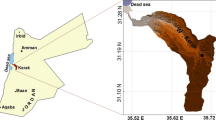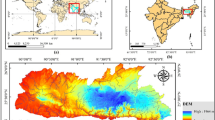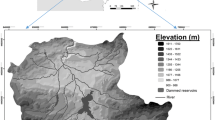Abstract
Soil erosion is one of the most serious land degradation problems all over the world, causing irreversible land quality reduction. In this paper, we modify the Revised Universal Soil Loss Equation (RUSLE) model by replacing the factors of slope length and gradient with Sediment Transport Index (STI). The Digital Elevation Model, terrain parameters, Normalized Difference Vegetation Index (NDVI), and rainfall data are used as inputs to the model. Along with the application of remote sensing techniques and ground survey measurements, erosion susceptibility maps are produced. The revised models are then used to obtain the optimal estimate of soil erosion susceptibility at Alianello of southern Italy, which is prone to soil erosion.
The soil loss estimated from the modified RUSLE model shows a large spatial variance, ranging from 10 to as much as 7000 ton ha−1 yr−1. The high erosion susceptible area constitutes about 46.8% of the total erosion area, and when classified by land cover type, 33% is “mixed bare with shrubs and grass”, followed by 5.29% of “mixture of shrubs and trees”, with “shrubs” having the lowest percentage of 0.06%. In terms of slope types, very steep slope accounts for a total of 40.90% and belongs to high susceptibility, whereas flat slope accounts for only 0.12%, indicating that flat topography has little effect on the erosion hazard. As far as the geomorphologic types are concerned, the type of “moderate steep-steep slopes with moderate to severe erosion” is most favorable to high soil erosion, which comprises about 9.34%.
Finally, we validate the soil erosion map from the adapted RUSLE model against the visual interpretation map, and find a similarity degree of 71.9%, reflecting the efficiency of the adapted RUSLE model in mapping the soil erosion in this study area.
Similar content being viewed by others
References
Auzet, A. V., J. Poesen, and C. Valentin, 2002: Soil patterns as a key controlling factor of soil erosion by water. Catena, 46, 85–87.
Basso, F., E. Bove, M. Del Prete, et al., 1996: The Agri Basin, Basilicata, Italy. Atlas of Mediterranean Environments in Europe: The Desertification Context. John Wiley and Sons, Inc., London, 144–149.
Burrough, P. A., and R. A. McDonnell, 1998: Principles of Geographic Information Systems. Oxford University Press, New York, 356 pp.
De Jong, S. M., and H. T. Riezebos, 1997: SEMMED: A distributed approach to soil erosion modelling. The 16th EARSel Symposium, Malta, 20–23 May 1996, 199–204.
Grimm, M., R. J. A. Jones, and L. Montanarella, 2003: Soil Erosion Risk in Italy: A Revised USLE Approach. European Soil Bureau Research Report No. 11, EUR 20677 EN. Office for Official Publications of the European Communities, Luxembourg, 26.
Hu, Q., C. J. Gantzer, P. K. Jung, et al., 2000: Rainfall erosivity in the Republic of Korea. J. Soil Water Conserv., 55(2), 115–120.
Jung, H. C., S. W. Jeon, and D. K. Lee, 2004: Development of soil water erosion module using GIS and RUSLE. The 9th Asia-Pacific Integrated Model (AIM) International Workshop, March 12–13, Tsukuba, Japan, 321–327.
Jones, D. S., D. G. Kowalski, and R. B. Shaw, 1996. Calculating revised universal soil loss equation (RUSLE) estimates on department of defense lands: A review of RUSLE factors and US army land condition-trend analysis (LCTA) data gaps. Center for Ecological Management of Military Lands, Department of Forest Science, Colorado State University, Fort Collins, Colorado, 1–9.
Kheir, R. B., O. Cerdan, and C. Abdallah, 2006: Regional soil erosion risk mapping in Lebanon. Geomorphology, 82, 347–359.
King, C., and G. Delpont, 1993: Spatial assessment of erosion: Contribution of remote sensing, a review. Remote Sens. Rev., 7, 223–232.
Lane, L. J., E. D. Shirley, and V. P. Singh, 1988: Modeling erosion on hillslopes. Modeling Geomorphological Systems. M. G. Anderson, Ed. New York City, John Wiley, Publ., 287–308.
Merritt, W. S., R. A. Letcher, and A. J. Jakeman, 2003: A review of erosion and sediment transport models. Environ. Model Software, 18(8–9), 761–799. doi: 10.1016/S1364-8152 (03)00078-1.
Moore, I. D., P. E. Gessler, G. A. Nielsen, et al., 1993: Soil attribute prediction using terrain analysis. Soil Sci. Soc. Amer. J., 57(2), 443–452.
Morgan, R. P. C., 1995: Soil Erosion and Conservation. Longman Group Limited: Essex, UK, 298 pp.
Oldeman, L. R., V. W. P. Van Engelen, and J. H. M. Pulles, 1990: The extent of human induced soil degradation. Annex 5 of World Man of the Status of Human-Induced Soil Degradation: An Explanatory Note (2nd edition).
Oldeman R. L., R. T. A. Hakkeling, and W. G. Sombroek, Eds., International Soil Reference and Information Center, Wageningen, 36.
Oliver, S., 1993: 20th-century urban landslides in the Basilicata region of Italy. Environ. Manage, 17(4), 433–444.
Pelletier, R. E., 1985: Evaluating nonpoint pollution using remotely sensed data in soil erosion models. J. Soil Water Conserv., 40(4), 332–335.
Renard, K. G., and J. R. Freimund, 1994: Using monthly precipitation data to estimate the R-factor in the revised USLE. J. Hydrol., 157(1–4), 287–306.
—, G. R. Foster, G. A. Weesies, et al., 1997: Predicting soil erosion by water: a guide to conservation planning with the Revised Universal Soil Loss Equation. Agricultural Handbook, Vol. 703. U.S. Department of Agriculture, 404.
Servenay, A., and C. Prat, 2003: Erosion extension of indurated volcanic soils of Mexico by aerial photographs and remote sensing analysis. Geoderma, 117(3-4), 367–375.
Smith, S. J., J. R. Williams, R. G. Menzel, et al., 1984: Prediction of sediment yield from Southern Plains grasslands with the Modified Universal Soil Loss Equation. J. Range Manage., 37(4), 295–297.
UNESCO-FAO, 1963: Ecology of the Mediterranean zone. Bioclimatic Map of the Mediterranean Zone (Arid Zone Research XXI-5 maps with explanatory notes), Paris, 56.
Van der Knijff, J. M., R. J. A. Jones, and L. Montanarella, 1999: Soil erosion risk assessment in Italy. EUR 19044EN. European Soil Bureau. Office for Official Publications of the European Communities, Luxembourg, 52.
—, —, and —, 2002: Soil erosion risk assessment in Italy. Proceedings of the Third International Congress Man and Soil at the Third Millennium. Rubio, J. L., Morgan, R. P. C., Asins, S., and V. Andreu, Eds. Geoforma Ediciones, Logrono, Spain, 903–1913.
Vrieling, A., 2006: Satellite remote sensing for water erosion assessment: A review. Catena, 65, 2–18.
—, G. Sterk, and O. Vigiak, 2006: Spatial evaluation of soil erosion risk in the West Usambara Mountains, Tanzania. Land Degrad. Dev., 17, 301–319.
Wischmeier, W. H., and D. D. Smith, 1978: Predicting rainfall-erosion losses: A guide to conservation planning. Agricultural Handbook, Vol. 537. U.S. Department of Agriculture, 1–537.
Author information
Authors and Affiliations
Corresponding author
Additional information
Supported by the Special Project on Public Welfare of Forestry (200804020), China Meteorological Administration Special Public Welfare Research Fund (GYHY201206040), National Science and Technology Support Program of China (2008BAC40B02), National Natural Science Foundation of China (41171294 and 40901169), Chinese Academy of Meteorological Sciences Basic Research Project (2011Y002 and 2010Z002), and One Hundred Talents Program of the Chinese Academy of Sciences.
Rights and permissions
About this article
Cite this article
Guo, J., Niu, T., Rahimy, P. et al. Assessment of soil erosion susceptibility using empirical modeling. Acta Meteorol Sin 27, 98–109 (2013). https://doi.org/10.1007/s13351-013-0110-2
Received:
Accepted:
Published:
Issue Date:
DOI: https://doi.org/10.1007/s13351-013-0110-2




